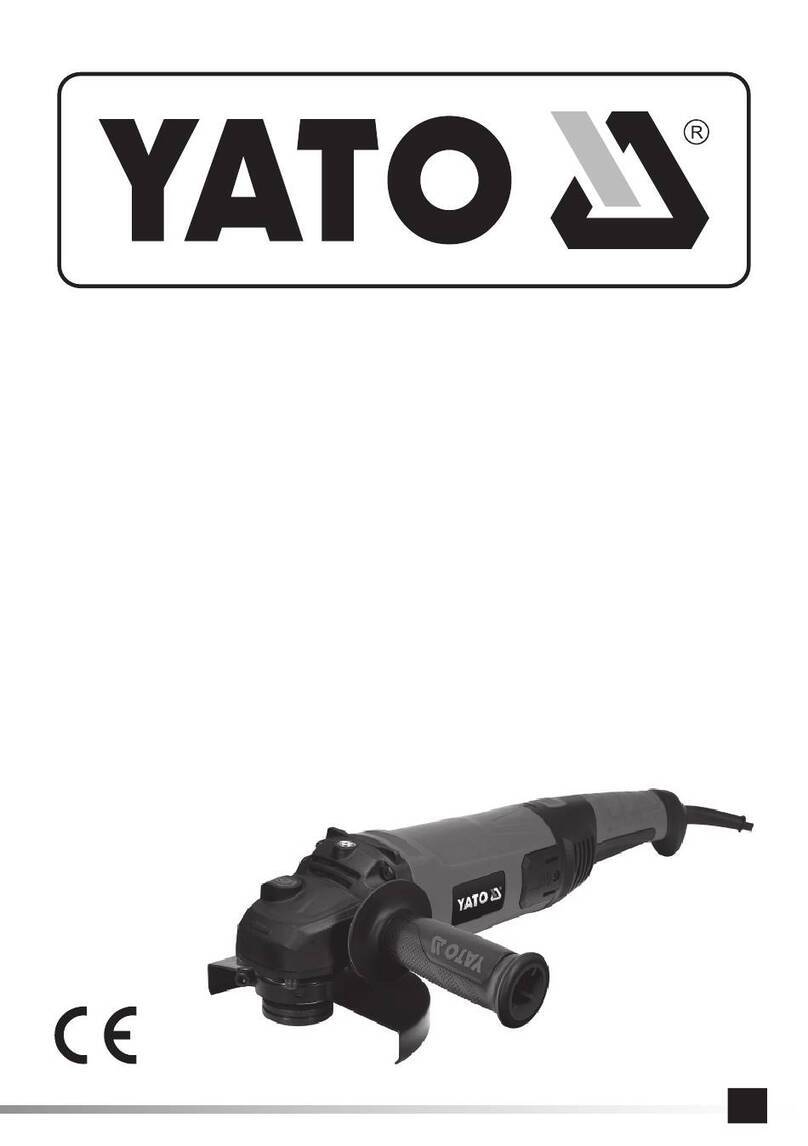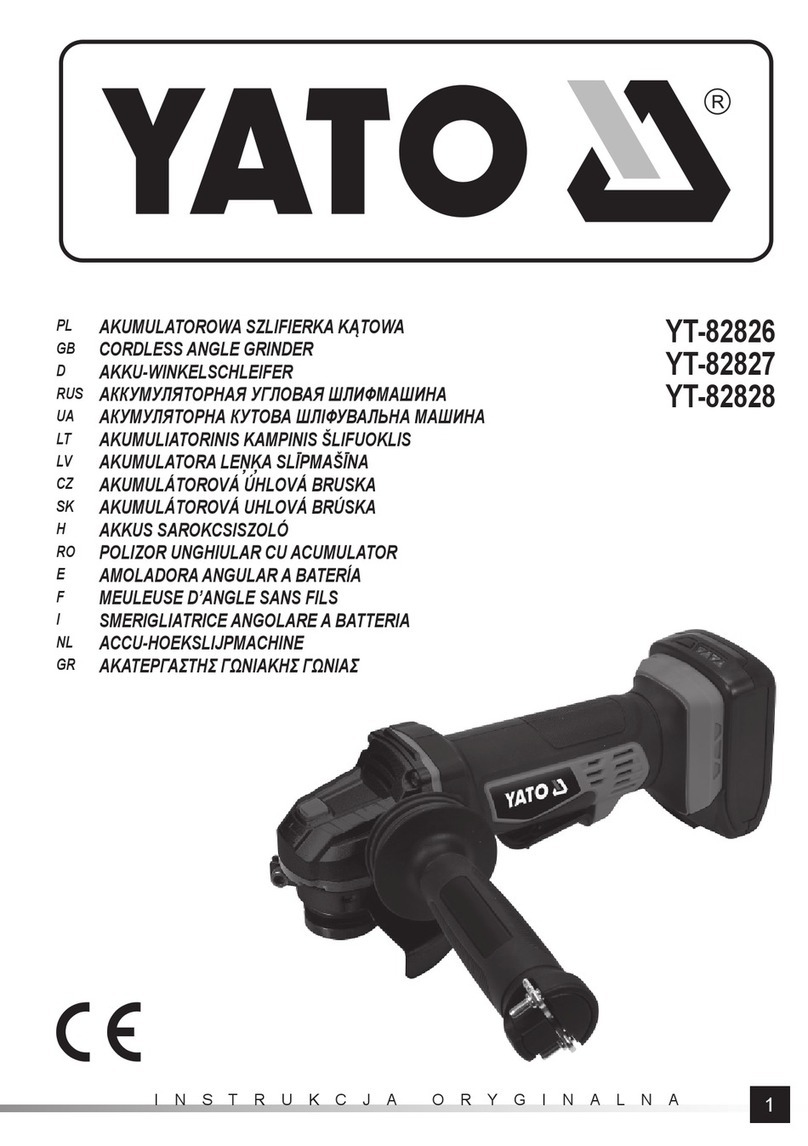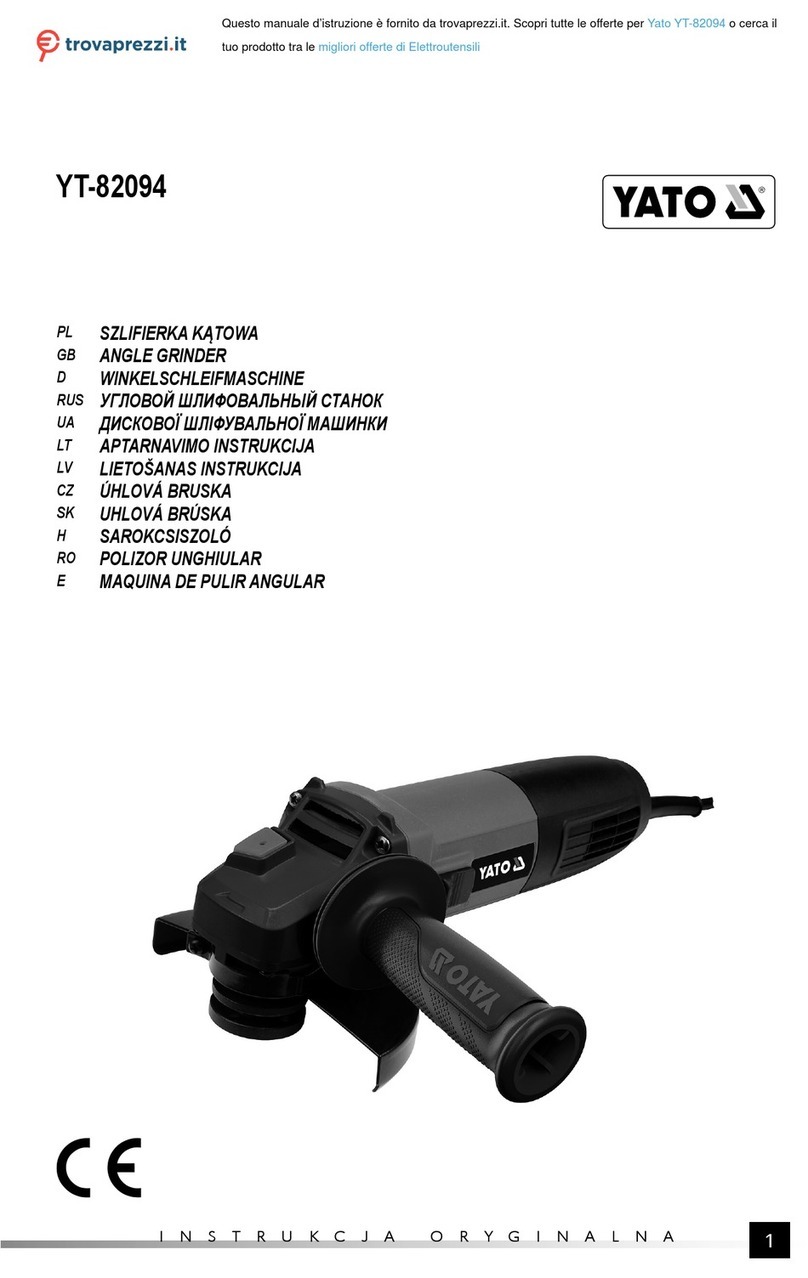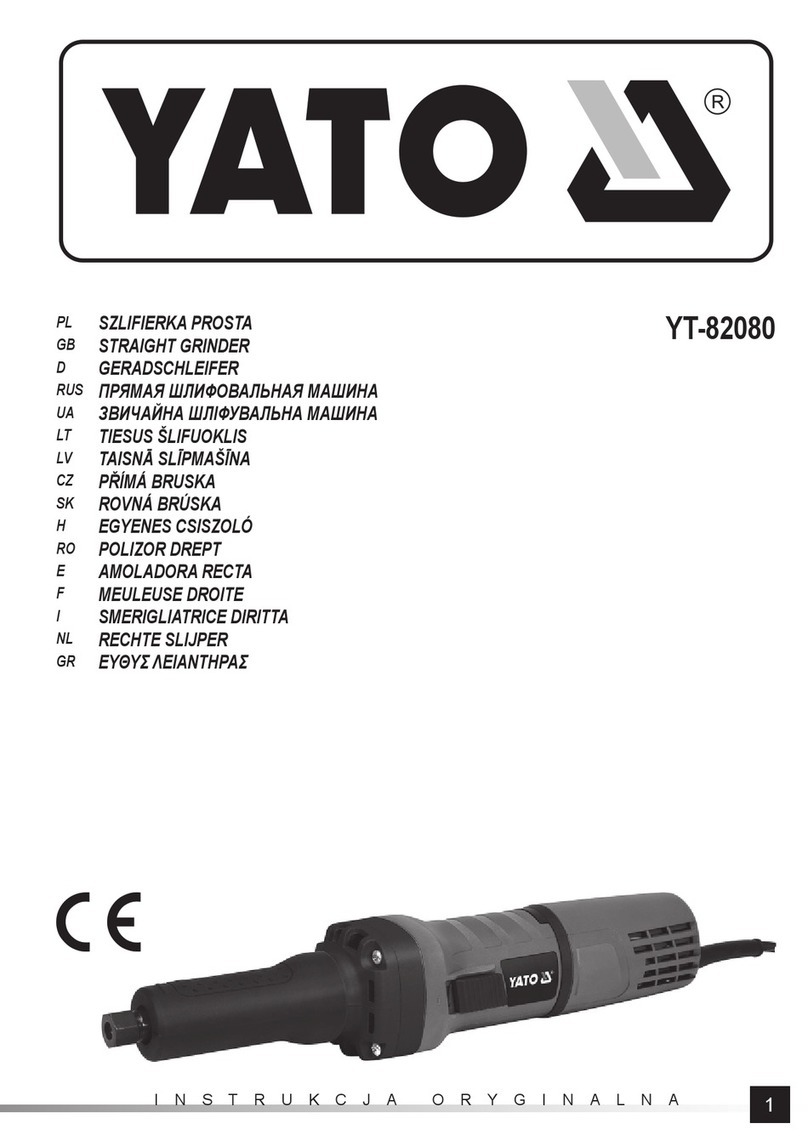YATO YT-09675 User manual

INSTRUKCJA ORYGINALNA 1
YT-09675
SZLIFIERKA KĄTOWA PNEUMATYCZNA
PNEUMATIC ANGLE GRINDER
DRUCKLUFT-WINKELSCHLEIFER
ПНЕВМАТИЧЕСКАЯ УГЛОВАЯ ШЛИФОВАЛЬНАЯ МАШИНА
ПНЕВМАТИЧНА КУТОВА ШЛІФУВАЛЬНА МАШИНА
PNEUMATINIS KAMPINIS ŠLIFUOKLIS
PNEIMATISKĀLEŅĶA SLĪPMAŠĪNAS
PNEUMATICKÉ ÚHLOVOU BRUSKU
PNEUMATICKÉ UHLOVÚ BRÚSKU
PNEUMATIKUS SAROKCSISZOLÓ
POLIZOR UNGHIULAR PNEUMATIC
AMOLADORA ANGULAR NEUMÁTICA
PL
GB
D
RUS
UA
LT
LV
CZ
SK
H
RO
E

INSTRUKCJA ORYGINALNA
2
PL GB D RUS UA LT LV CZ SK H RO E
TOYA S.A. ul. Sołtysowicka 13-15, 51-168 Wrocław, Polska; www.yato.pl
Rok produkcji:
Production year: Produktionsjahr:
Год выпуска:Рік випуску:
Pagaminimo metai:
2018 Ražošanas gads:
Rok výroby: Rok výroby:
Gyártási év: Anul producţiei utilajului:
Año de fabricación:
I II
III IV
V VI
VII
5
3
2
1
7
8
4
6
8
9
10
9
10
11
12 14
13
15 16
17 18

INSTRUKCJA ORYGINALNA 3
PL GB D RUS UA LT LV CZ SK H RO E
1. wlot powietrza
2. złącze wlotu powietrza
3. spust (włącznik)
4. blokada włącznika
5. obudowa
6. osłona ściernicy
7. rękojeść dodatkowa
8. ściernica
9. górny kołnierz mocujący
10. dolny kołnierz mocujący
11. narzędzie
12. gniazdo węża
13. wąż
14. złączka węża
15. smarownica
16. reduktor
17. filtr
18. kompresor
1. air filter
2. air inlet connector
3. drain (switch)
4. switch lock
5. housing
6. grinding wheel guard
7. additional handle
8. grinding wheel
9. upper mounting flange
10. lower upper mounting flange
11. tool
12. hose socket
13. hose
14. hose connector
15. grease gun
16. reducer
17. filter
18. compressor
1. воздухозаборник
2. штуцер для подачи сжатого воздуха
3. кнопка включения
4. блокировка кнопки включения
5. корпус
6. защитный кожух абразивного круга
7. дополнительная рукоятка
8. абразивный круг
9. верхний зажимный фланец
10. нижний зажимный фланец
11. сменный рабочий инструмент
12. гнездо шланга
13. шланг
14. соединитель шланга
15. масленка
16. редуктор
17. фильтр
18. компрессор
1. повітрозабірник
2. штуцер для подачі стисненого повітря
3. кнопка ввімкнення
4. блокування кнопки ввімкнення
5. корпус
6. захисний кожух абразивного круга
7. допоміжна рукоятка
8. абразивний круг
9. верхній затискний фланець
10. нижній затискний фланець
11. змінний робочий інструмент
12. гніздо шланга
13. шланг
14. з’єднувач шланга
15. лубрикатор
16. редуктор
17. фільтр
18. компресор
1. oro įėjimas
2. oro įėjimo jungtis
3. mygtukas (jungiklis)
4. jungiklio blokuotė
5. korpusas
6. abrazyvinio disko gaubtas
7. papildomoji rankena
8. abrazyvinis diskas
9. viršutinis įtvirtinimo diskelis
10. viršutinis įtvirtinimo diskelis
11. įrankis
12. žarnos lizdas
13. žarna
14. žarnos mova
15. tepalinė
16. redukcinėmova
17. filtras
18. kompresorius
PL GB
RUS UA LT
1. Lufteinlass
2. Lufteinlassstutzen
3. Luftauslass (Schalter)
4. Blockade des Schalters
5. Gehäuse
6. Abdeckung der Schleifscheibe
7. Zusätzlicher Handgriff
8. Schleifscheibe
9. Oberer Befestigungsflansch
10. Unterer Befestigungsflansch
11. Werkzeug
12. Schlauchbuchse
13. Schlauch
14. Schlauchverbinder
15. Schmiervorrichtung
16. Reduktor
17. Filter
18. Kompressor
D
max. 30O
IXVIII

INSTRUKCJA ORYGINALNA
4
PL GB D RUS UA LT LV CZ SK H RO E
1. gaisa pievads
2. gaisa pievada savienojums
3. sprūds (ieslēdzējs)
4. ieslēdzēja blokāde
5. korpuss
6. abrazīvas ripas segums
7. papildus rokturis
8. abrazīva ripa
9. stiprinošāaugšējāuzmava
10. stiprinošāapakšējāuzmava
11. ierīce
12. šļūtenes ligzda
13. šļūtene
14. vada savienojums
15. eļļas kanniņa
16. reduktors
17. filtrs
18. kompresors
1. vstup vzduchu
2. spojka vstupu vzduchu
3. spoušť(vypínač)
4. aretace spouště
5. skříňnářadí
6. kryt brusného (řezného) kotouče
7. pomocná rukojeť
8. brusný (řezný) kotouč
9. horní upínací kroužek
10. dolní upínací kroužek
11. nástroj
12. přípojka hadice
13. hadice
14. spojka hadice
15. olejovač
16. redukční ventil
17. filtr
18. kompresor
1. vstup vzduchu
2. spojka vstupu vzduchu
3. spúšť(vypínač)
4. aretácia spúšte
5. skriňa náradia
6. kryt brúsneho (rezného) kotúča
7. pomocná rukoväť
8. brúsny (rezný) kotúč
9. horný upínací krúžok
10. dolný upínací krúžok
11. nástroj
12. prípojka hadice
13. hadica
14. hadicová spojka
15. olejovač
16. redukčný ventil
17. filter
18. kompresor
1. levegőbemenet
2. levegőbemenet
3. kioldó (kapcsoló)
4. a kapcsoló retesze
5. ház
6. tárcsavédőburkolat
7. kiegészítőfogantyú
8. vágótárcsa
9. felsőrögzítőkarima
10. alsó rögzítőkarima
11. szerszám
12. tömlőfogadó csatlakozó
13. tömlő
14. tömlőcsatlakozója
15. zsírzó
16. nyomáscsökkentő
17. szűrő
18. kompresszor
1. intrare aer
2. racord intrare aer
3. trăgaci (comutator)
4. blocarea comutatorului
5. carcasa
6. carcasădisc abraziv
7. mâner adiţional
8. disc abraziv
9. flanşă de fixare sus
10. flanşă de fixare jos
11. unealtă
12. soclu furtun
13. furtun
14. racord furtun
15. gresor
16. reductor
17. filtru
18. compresor
1. entrada de aire
2. conector de entrada de aire
3. gatillo (interruptor)
4. bloqueo del interruptor
5. caja
6. protección de la muela
7. empuñadura adicional
8. muela
9. brida superior de fijación
10. brida inferior de fijación
11. herramienta
12. toma de manguera
13. manguera
14. conector de manguera
15. lubricador
16. reductor
17. filtro
18. compresor
LV CZ SK
HRO E
Przeczytaćinstrukcję
Read the operating instruction
Bedienungsanleitung durchgelesen
Прочитать инструкцию
Прочитать iнструкцiю
Perskaityti instrukciją
Jālasa instrukciju
Přečtet návod k použití
Prečítaťnávod k obsluhe
Olvasni utasítást
Citeşti instrucţunile
Lea la instrucción
Używaćgogli ochronnych
Wear protective goggles
Пользоваться защитными очками
Користуйтесь захисними окулярами
Vartok apsauginius akinius
Jālieto drošības brilles
Používej ochranné brýle
Používaj ochranné okuliare
Használjon védőszemüveget!
Intrebuinţeazăochelari de protejare
Use protectores del oído
Używaćochrony słuchu
Wear hearing protectors
Пользоваться средствами защиты слуха
Користуйтесь засобами захисту слуху
Vartoti ausines klausai apsaugoti
Jālieto dzirdes drošības līdzekļu
Používej chrániče sluchu
Používaj chrániče sluchu
Használjon fülvédőt!
Intrebuinţeazăantifoane
Use protectores de la vista
Stosowaćrękawice ochronne
Schutzhandschuhe verwenden
Необходимо пользоваться защитными
перчатками
Слід користуватися захисними рукавицями
Vartoti apsaugines pirštines
Lietot aizsardzības cimdus
Používejte ochranné rukavice
Používajte ochranné rukavice
Használjon védőkesztyűt
Utilizarea mănuşilor de protrcţie
Use guantes de protección

INSTRUKCJA ORYGINALNA 5
PL
CHARAKTERYSTYKA PRODUKTU
Szlifierka kątowa pneumatyczna jest narzędziem zasilanym strumieniem sprężonego powietrza. Za pomocąściernic mocowa-
nych na wrzecionie umożliwia szlifowanie i cięcie metalu. Narzędzie jest przystosowane do pracy wewnątrz pomieszczeńi nie
należy wystawiaćgo na działanie wilgoci oraz opadów atmosferycznych. Prawidłowa, niezawodna i bezpieczna praca narzędzia
jest zależna od właściwej eksploatacji, dlatego:
Przed przystąpieniem do pracy z narzędziem należy przeczytaćcałą instrukcjęi zachowaćją.
Za wszelkie szkody i obrażenia powstałe w wyniku używania narzędzia niezgodnie z przeznaczeniem, nie przestrzegania prze-
pisów bezpieczeństwa i zaleceńniniejszej instrukcji, dostawca nie ponosi odpowiedzialności. Używanie narzędzia niezgodnie z
przeznaczeniem, powoduje także utratępraw użytkownika do gwarancji, a także z tytułu niezgodności z umową.
WYPOSAŻENIE
Szlifierka dostarczana jest w stanie kompletnym, jednak przed rozpoczęciem pracy należy jąprzygotowaćwg instrukcji podanych
w dalszej części instrukcji. Wraz ze szlifierkądostarczane są:
- rękojeść dodatkowa,
- przyłącze do instalacji sprężonego powietrza
- klucze do montażu i demontażu ściernicy
Uwaga! Szlifierka nie jest wyposażona w ściernice.
DANE TECHNICZNE
Parametr Jednostka miary Wartość
Numer katalogowy YT-09675
Waga [kg] 1,7
Średnica przyłącza powietrza (PT) [” / mm] 6,3 / 1/4
Średnica węża doprowadzającego powietrze (wewnętrzna) [” / mm] 10 / 3/8
Rozmiar gwintu wrzeciona - M10
Średnica ściernicy [mm] 125
Średnica otworu ściernicy [mm] 16, 22
Maksymalne ciśnienie pracy [MPa] 0,65
Obroty maksymalne [min-1] 11 000
Wymagany przepływ powietrza (przy 0,63 MPa) [l/min] 141
Ciśnienie akustyczne (ISO 15744) [dB(A)] 87 ± 3
Moc akustyczna (ISO 15744) [dB(A)] 98 ± 3
Drgania (ISO 28927-1) [m/s2] 3,4 ± 1,5
OGÓLNE WARUNKI BEZPIECZEŃSTWA
OSTRZEŻENIE! Podczas pracy narzędziem pneumatycznym zaleca sięzawsze przestrzegaćpodstawowych zasad bezpieczeń-
stwa pracy, łącznie z podanymi niżej, w celu ograniczenia zagrożenia pożarem, porażenia prądem elektrycznym oraz uniknięcia
obrażeń.
Przed przystąpieniem do eksploatacji niniejszego narzędzia przeczytaćcałą instrukcjęi zachowaćją.
UWAGA! Przeczytaćwszystkie poniższe instrukcje. Nieprzestrzeganie ich może prowadzićdo porażenia elektrycznego, pożaru
albo do uszkodzeńciała. Pojęcie „narzędzie pneumatyczne” użyte w instrukcjach odnosi siędo wszystkich narzędzi napędzanych
strumieniem sprężonego powietrza pod odpowiednim ciśnieniem.
PRZESTRZEGAĆPONIŻSZE INSTRUKCJE
Ogólne zasady bezpieczeństwa
Przed rozpoczęciem instalacji, pracy, naprawy, konserwacji oraz zmiany akcesoriów lub w przypadku pracy w pobliżu narzędzia
pneumatycznego z powodu wielu zagrożeń, należy przeczytaći zrozumiećinstrukcje bezpieczeństwa. Nie wykonanie powyż-
szych czynności może skutkowaćpoważnymi obrażeniami ciała. Instalacja, regulacja i montażnarzędzi pneumatycznych może
byćwykonywany tylko przez wykwalifikowany i wyszkolony personel. Nie modyfikowaćnarzędzia pneumatycznego. Modyfikacje
mogązmniejszyćefektywność oraz poziom bezpieczeństwa oraz zwiększyćryzyko operatora narzędzia. Nie wyrzucaćinstrukcji
bezpieczeństwa, należy je przekazaćoperatorowi narzędzia. Nie używaćnarzędzia pneumatycznego, jeżeli jest uszkodzone.
Table of contents
Languages:
Other YATO Grinder manuals
Popular Grinder manuals by other brands

Meterk
Meterk S1M-GW20-115 Translation of the original instructions

U.S.SAWS
U.S.SAWS SX65000C operating manual

Parkside
Parkside PWS 230 C3 Translation of the original instructions

SUHNER ABRASIVE
SUHNER ABRASIVE ASC 9 Technical document

PTA
PTA P1322 Operation manual

Craftsman
Craftsman CMCG400 instruction manual































